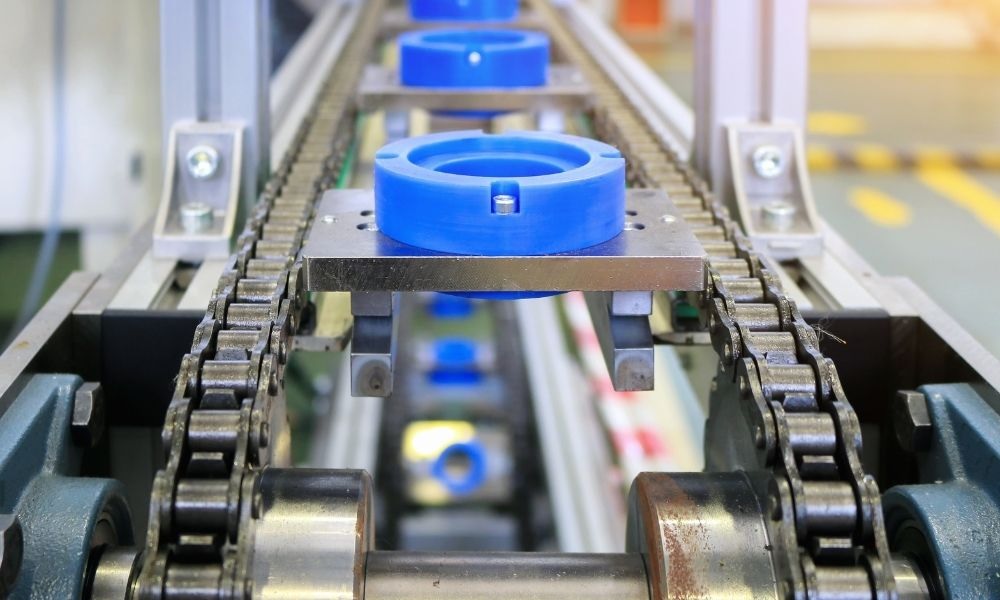Konvejerių grandinių alyvų aerozoliai
Konvejerių sistemų grandinės apžiūra yra tokia pat svarbi, kaip ir kitų įrenginių apžiūra. Konvejeriui sustojus, su juo dažniausiai sustoja tam tikra gamybos proceso dalis. Grandinės gedimas dėl geros priežiūros programų trūkumo gali ir dažnai sukelia tiek pat prastovų, kiek ir bet kuri gamyklos įranga. Ir vis dėlto, grandinei skiriama mažiau dėmesio nei daugumai kitų susirūpinimą keliančių sričių, nes jai teikiama mažai reikšmės. Sėkmingam grandininių konvejerių veikimui reikalingi tame tarpe ir grandinių alyvos aerozolis.

Kai įmanoma, sutepkite grandinę darbine emulsija su švariu vandeniu, tiekiamu konvejerio galinėje dalyje, krovinio pusėje. Tai leis grandinei perkelti vandenį per visą nusidėvėjimo juostos ilgį ir išlaikyti paviršių glotnų. Jei vandens naudoti negalima, dažnai sėkmingai galima pakeisti plonu aliejaus purškikliu. Atminkite, kad alyva netinka kai kurioms reikmėms, pavyzdžiui, daugeliui rąstų denių, kur gali būti daug nešvarumų. Sąlygos visada nulems, kokio tipo ir kiek galima naudoti lubrikantą.
Purškiama konvejerio grandinės alyva
Tepimas sukuria slidžią plėvelę ant grandinės ir kitų komponentų, kurie gali sugadinti grandinę. Ši plėvelė sušvelnina metalo ir metalo kontakto poveikį, atsirandantį įrenginiui veikiant, sumažindama trintį ir susidėvėjimą. Tinkamas tepimas taip pat padeda grandinėms ir grandinės komponentams atsispirti korozijai, nes sukuria barjerą, apsaugantį nuo drėgmės. Tepimas taip pat padeda sumažinti triukšmą, kylantį, kai veikia konvejerio sistemos.
Taip pat svarbu, kaip tepamas. Norint apsaugoti grandinę nuo korozijos ir nusidėvėjimo, reikia tinkamai sutepti. Nepakanka tik teptuku tepti grandinės plokštes; tepalas turi būti tepamas tarp vidinių ir išorinių plokščių virš nuolydžio taško. Jis taip pat turi būti naudojamas tarp vidinių plokščių ir ritinėlių grandinėse su ritinėliais. Tai užtikrins, kad tepalas pateks į guolių paviršius ir apsaugo juos nuo trinties ir susidėvėjimo.
Grandinės ir konvejerio tepalas Chain Drive Fluid
Aukštos kokybės EP grandinės ir konvejerio tepalas, kurio unikali formulė užtikrina maksimalų įsiskverbimo, tepimo ir apsaugos nuo korozijos našumą. Labai universalus, didelio našumo, bendrosios paskirties grandinių tepalas, tinkantis visų tipų pavaroms ir konvejerio grandinėms.
Molylub CHAIN DRIVE Fluid yra didelio našumo grandinių ir konvejerių tepalas, skirtas efektyviai prasiskverbti, sutepti ir apsaugoti nuo korozijos.
- Bendrosios paskirties grandinių tepalas
- Geros krovinio nešimo savybės
- Puikus įsiskverbimas į jungtis ir kaiščius
- Geras atsparumas vandens plovimui
- Puiki apsauga nuo korozijos
- Ilgalaikis tepimas
- Temperatūros diapazonas -15ºC iki +120ºC
| Rūšis | Darbinės temperatūros, ° C | Spalva | Pagrindas | Panaudojimas, savybės |
| Molyduval |
-20°C iki +270 |
žalsva |
Alyva Sint Ester |
Grandininės alyvos pagrindo konvejerių aerozoliai.Sintetinės aukštatemperatūrinės, ISO VG 220 klampumo grandinių alyvos su kompleksinių priedų paketu pagrindo aerozolis. Stabilus temperatūros poveikiui, mažas išgaruojamumas, geros adhezinėmis savybės, įsigeriamumas. Džiovinimo krosnių, pasterizavimo įrangose, lakavimo bei kepimo krosnių grandinėms, pavarų ir transporterių grandinėms, tekstilės, chemijos pramonei
|
| Molyduval |
-40°C iki +250 |
balta |
Alyva Sint SHC + PTFE |
Tefloninės grandinių alyvos pagrindo aerozoliai.Sintetinės ypač aukšto ISO VG 1000 klampumo grandinių alyvos kietaisiais Teflono tepikliais aerozolis. Sintetinio pagrindo skysčiai užtikrina puikias stabilumo savybes prie aukštų, iki 250°C temperatūrų, Aukščiau jų įsijungia avarinės tepalo tepimo savybės su sudėtyje esančiais baltaisiais tepikliais. Grandinių tepimui padidinto reikalavimo švarumui pramonės šakose (tekstilės, baldų, medienos apdirbimo, popieriaus ir pakuotės gamybos įmonės), neleidžiančiose naudoti tamsias, grafitinio – molibdeno disulfido pagrindo alyvas. Tefloninio sutepimo reikalaujančioms, su plastiku bei guma kontaktuojančioms grandinėms, konvejerių juostoms PTFE dalelės : 0,35 µm |
Surinkimo linijų konvejeriai labai pagerina efektyvumą ir saugumą gamyklose, sandėliuose, komunalinių paslaugų įmonėse ir kitose patalpose, tačiau tik tada, kai jie yra pradėti ir veikia. Jūsų konvejerio sistemos prastovos gali brangiai kainuoti ir dėl to jūsų įrenginys atsilieka nuo svarbių operacijų. Tinkama konvejerio grandinės priežiūra užtikrins, kad ši neįkainojama įranga ir toliau teiks investicijų grąžą ilgą laiką.
Lubrication Effects on Chain Operation
Dauguma grandininių pavarų ir konvejerių veiks geriau ir tarnaus ilgiau, kai bus laiku ir tinkamai sutepti. Viena taisyklė yra ta, kad tinkamas tepimas gali pailginti grandinės tarnavimo laiką net 100 kartų.
Net jei bendras grandinės tarnavimo laikas yra priimtinas, tinkamo tepimo trūkumas gali sukelti kitų problemų. Kai grandinei reikia sutepti, vienos jungties susidėvėjimas gali labai skirtis, todėl veiksmas gali būti nereguliarus. Dėl greito jungties susidėvėjimo konvejeris gali anksti prarasti laiką. Tepimo trūkumas gali padidinti trintį ir energijos sąnaudas bei sukelti žalingą temperatūros kilimą.
Reikalingas tepimas
Grandinės tepimas daugiausia reikalingas siekiant sulėtinti susidėvėjimą tarp kaiščių ir įvorių grandinės jungtyse, išplauti susidėvėjusias šiukšles ir pašalines medžiagas ir išlyginti grandinės sukibimą su žvaigždute. Be to, gali prireikti tepimo, kad būtų išvengta rūdžių ir korozijos, pašalinta šiluma ir amortizuojama smūgio jėga.
Konvejerio grandinės pavaros tepalas
Grandinės tepalas turi būti pakankamai mažo klampumo, kad prasiskverbtų į svarbiausius vidinius paviršius, ir pakankamai didelio klampumo arba būtinų priedų, kad išlaikytų efektyvią plėvelę esant vyraujančiai temperatūrai ir slėgiui. Rekomenduojamas klampumas įvairiems aplinkos temperatūrų diapazonams yra parodytas 1 lentelėje. Tepalas turi išlaikyti norimas tepimo savybes vyraujančiomis eksploatavimo sąlygomis, būti švarus ir be korozijos.
Paprastai yra priimtina geros rūšies nevalianti naftos bazinė alyva. Nors ploviklių paprastai nereikia, dažnai padeda putojantys, antioksidaciniai ir didelio slėgio priedai. Reikėtų vengti nešvarių aliejų. Aliejuje esančios rūgštys arba abrazyvai gali visam laikui sugadinti grandinę.
Grandinės gamintojas dažnai kaip pradinį tepalą naudoja tepalą arba vazeliną. Tačiau naudotojai paprastai neturėtų eksploatuojamų grandinių tepti tepalais, nes jie yra per stori, kad prasiskverbtų į vidinius grandinės guolių paviršius. Naudotojai turėtų naudoti tepalą tik tada, kai yra jungiamosios detalės tepalui įpurkšti į grandinės jungtis.
Grandininės pavaros tepimo alyva
- Grandininių pavarų tepimasRekomenduojamas grandininių pavarų tepimo būdas nurodytas ASME B29 serijos standartuose ir įvairių gamintojų kataloguose paskelbtose galios lentelėse. Paprastai išvardyti metodai yra rankinis, lašinamas, alyvos vonia, slankiklis ir alyvos srautas. Visais būdais alyva turi būti tepama ant viršutinių grandies plokštės arba šoninės juostos kraštų apatiniame grandinės tarpatramyje. Tai leidžia gravitacijai ir išcentrinei jėgai nunešti tepalą į kritines guolių sritis.
